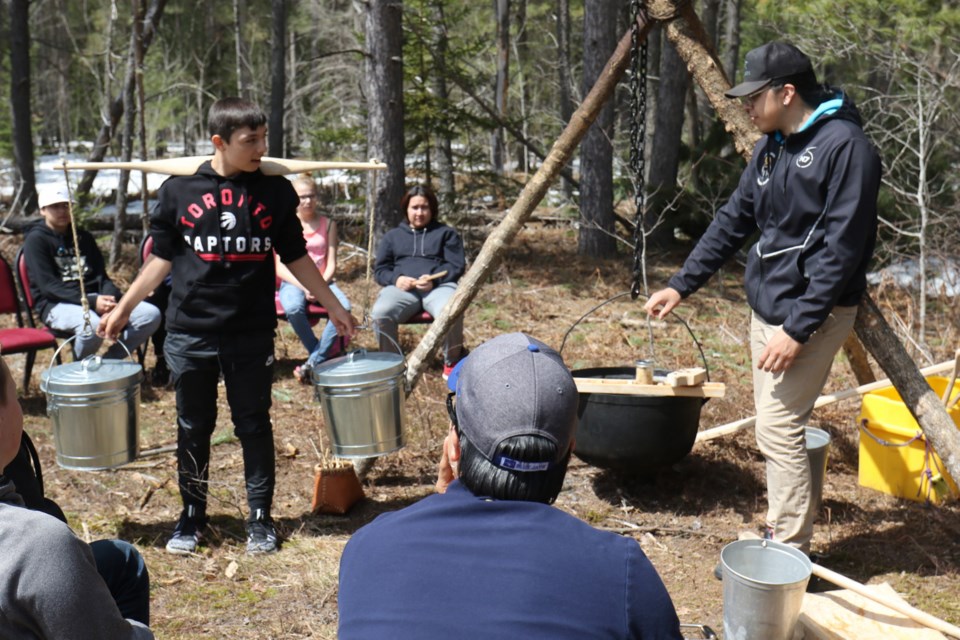Roughly two dozen students from Korah Collegiate and Superior Heights are in Garden River First Nation on Thursday afternoon, and they’re learning some Anishinaabemowin, also known as the Ojibwe language, from Miish Shawanda of Great Lakes Cultural Camps while maple sap boils over an open fire.
This land-based, cultural teaching is just one component of an ongoing revision of the Indigenous curriculum within the Algoma District School Board (ADSB).
“He’s sharing some of the translations in terms of the words in the Anishinaabemowin, and giving a bit of the steps and processes to how that collection process happens in an Anishinaabe sugar bush camp,” said Maheengun Shawanda, director & founder of Great Lakes Cultural Camps.
The collaboration is the result of a proposal put forward by the ADSB to the Ministry of Education for a series of Indigenous student cultural leadership camps. During the first week of March, Great Lakes Cultural Camps held its first joint effort with ADSB at Serpent River First Nation for self-identifying Indigenous students from grades 7-10 in Elliot Lake and Blind River.
The move is part of this year’s ‘soft implementation’ of the school board’s revised Indigenous curriculum, with the official launch slated to happen in September.
During a presentation at the ADSB committee of the whole meeting on Tuesday, superintendent Joe Maurice outlined how the curriculum will be revised to better reflect Indigenous culture and worldview.
“We’re all Canadians, so I think understanding our neighbours, understanding each other, I think is a huge benefit to everybody,” Maurice told SooToday following Tuesday’s meeting. “It’s our history.”
When school begins for elementary and high school students this fall, social studies classes from grades 4-6, and history classes for grades 7,8 and 10 will focus on incorporating more Indigenous perspective into the curriculum, particularly in the areas of treaties, the Indian Act and the residential school system.
The move, Maurice told trustees, is a direct response to ‘calls to action’ numbers 62 and 63 of the Truth and Reconciliation Commission.
Overall, there will be 21 Indigenous courses in 9 ADSB schools, and six Anishinaabe language courses in four of its schools across the Algoma District come this September.
“Previously, we had one high school that offered language, we now have four high schools offering language, including two here in the Sault and two in our district,” Maurice said.
The ADSB started a language class pilot in Michipicoten High School in Wawa, which will grow into a full class for next year. Maurice says there’s also ‘continued growth’ in Elliot Lake with a ‘very full class.’
Here in Sault Ste. Marie, the board will have a full Anishinaabe language class at Superior Heights, where they didn’t have one before.
Maurice told SooToday that finding language teachers who are fluent in Anishinaabemowin could pose a challenge. If the board can’t meet its desired staffing numbers, it would, as a contingency plan, try to get Anishinaabe elders in to speak more of the language, even it’s in a non-classroom setting, as a way of increasing exposure to the language.
“I guess the biggest challenge is making sure we have teachers that can teach the language, and that’s been part of what we’re trying to work through,” Maurice said.
In an effort to improve upon graduation rates for Indigenous high school students, the school board has also implemented ‘graduation coaches’ for two of its Sault-area secondary schools.Cherie Sewell, who was previously a cultural support worker for Garden River First Nation students at White Pines Collegiate and Vocational School, will now be employed as a graduation coach for Indigenous students at White Pines.
“We’re hoping that it will help to help our Indigenous students...feel more comfortable in some of their environments, that they will have an advocate within the school,” said Maurice. “Those that are dreaming of going to post-secondary, there’ll be someone there that works directly with them, helping to guide them through that process.”
The school board is not just looking at ways to better accommodate Indigenous students, but also ways of educating all staff and students Indigenous culture and worldview with the entire student body.
“Teachers are talking about it more, parents are talking about it more,” Maurice said. “I think we’re seeing overall growth, I think it’s a long journey...but we’re seeing growth.”
